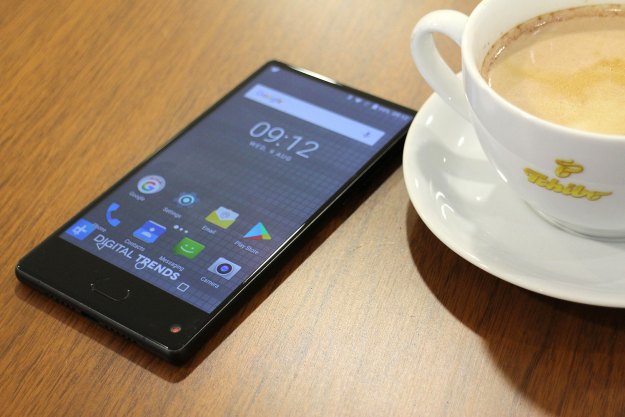
“Don’t let the Maze Alpha’s futuristic looks and rock solid performance fool you, it’s astonishingly good value.”
- Superb screen
- Long battery life
- No bloatware
- Excellent value
- Camera disappoints
- No 4G LTE in the United States
- Import only
The Maze Alpha is a smartphone you have likely never heard of, but it brings together technology you normally have to spend $600 or more to get, into a sub-$225 device. That’s right, like the Samsung Galaxy S8, LG G6, or Xiaomi Mi Mix, it has a massive, almost edge-to-edge screen for a futuristic look that’s achingly cool right now, at a price that’s shockingly good value. Throw in a dual-lens camera and it ticks all the must-have boxes for a smartphone this year.
A budget Mi Mix
At first glance, the Maze Alpha looks almost identical to the Xiaomi Mi Mix; but get closer and there are several differences, all of which enable Maze to charge a lot less for the Alpha. What do you miss out on? There’s no piezoelectric speaker behind the screen, the display is smaller, the bezels slightly larger, and the base section much deeper. The fingerprint sensor is on the front too — it’s not made of ceramic, and doesn’t have any 18k gold finishing touches either.
The great thing is, not all of these features detract from the Maze Alpha, and none turn it into a bad phone. There is a real speaker above the screen, but it’s so tiny you have to look for it. The Maze Alpha’s glass and metal combination also has more grip than Xiaomi’s phone.
You need it. This is a big phone. The Alpha is even larger than an iPhone 7 Plus, and is slab-like in shape, therefore you need to hang on tight unless you want it clattering on the floor. The front fingerprint sensor should be on the back though, as it’s awkward to use with one hand in its current position. It’s sometimes slow to respond, and we often needed a couple of tries before it unlocked the phone. The low price means corners have certainly been cut. Still, the overall construction of the Alpha is excellent. There are no sharp edges, no poorly-fitted panels, and the whole phone feels very high quality.
It ticks all the must-have boxes for a smartphone this year.
The screen is the reason to buy the Maze Alpha. It’s 6-inches with a 1,920 x 1,080 pixel resolution, and covered in a 2.5D piece of curved Gorilla Glass 4, resulting in an 83 percent screen-to-body ratio. It looks fantastic, with strong colors, high contrast, and plenty of brightness. Even with the brightness set halfway, it’s easily visible in sunlight. Videos looks superb, and when played through YouTube, they fit the screen well. It’s an immersive viewing experience, which is unlike most other phones, particularly at this price. It’s the same browsing the web, where more information is visible at one time, resulting in fewer swipes.
Android 7.0 Nougat is installed and our review model it had the August 2017 Android security patch already. Maze has left
Speedy and good battery life, poor camera
A MediaTek Helio P25 processor with 4GB of RAM powers the phone, with a large 4,000mAh battery to keep it going. Standby time is exceptional, and the phone happily lasted for a couple of days without a recharge. It has a USB Type-C connector and fast-charging, although it still takes a good while to top up a cell that big. Performance is good. The Alpha played simple games like Happy Hop without a problem, and Reckless Racing 3 with the graphics turned up was free of jitter. The Maze Alpha is a good gaming phone due to the large screen too.
Sadly, the camera lets the Maze Alpha down. The dual-camera setup features a 13-megapixel main camera and a secondary 5-megapixel lens — it doesn’t replicate the Portrait Mode effect on the iPhone, but instead it’s used for increasing quality and contrast, a monochrome mode, plus a 2x optical zoom. In the right conditions it takes pleasant photos, but it’s never outstanding. The f/2.2 aperture makes low-light and overcast day shots a real challenge. The Maze Alpha’s camera is what we’d expect a phone costing this amount to be like, but that’s not really a good thing.
The app has modes for monochrome shots, video, and a Pro mode, plus a comprehensive editing suite. To use the selfie camera, you have to spin the phone round, as it’s under the screen, unless you like pictures of your neck. It’s worth mentioning Maze has pushed at least one software update to our phone since we’ve been using it, and that did improve the camera performance and responsiveness. We hope it continues to refine the camera more.
We like the Maze Alpha. Phones priced at around $200 tend to all look the same, and while the Maze Alpha looks a lot like the Xiaomi Mi Mix, at least it doesn’t look like the iPhone. The screen’s a beauty, the battery lasts ages, and the performance is strong. The camera is just acceptable, and can’t match more expensive devices for low light shots. The major downside is the lack of 4G LTE support in the U.S. We tested the Maze Alpha in the U.K., and it connected to O2’s 4G network without a problem.
It’s an import phone, so don’t go looking for it at Best Buy. Chinese electronics specialist GearBest sells the Maze Alpha for $225 at the time of writing, and has good after sales support and warranties. It’s available elsewhere too, and if you’re lucky it can be found for under $190. If you’re prepared to go without super fast data, and only have a few hundred dollars to spend on a phone, the Maze Alpha stands out from the crowd. It certainly won’t get mistaken it for many other phones when you put it down on a table.












